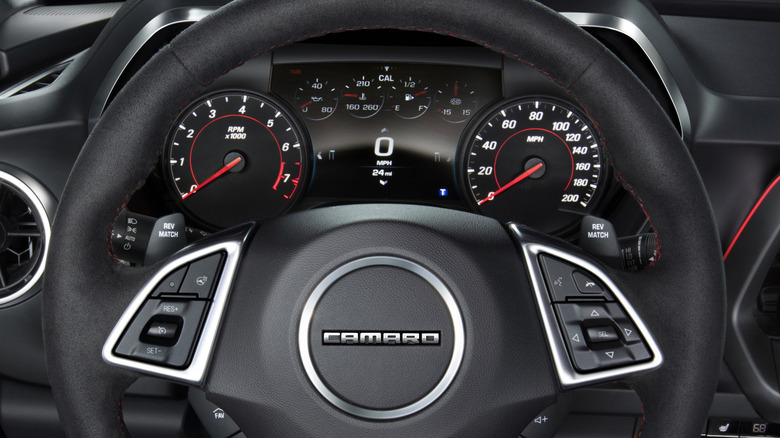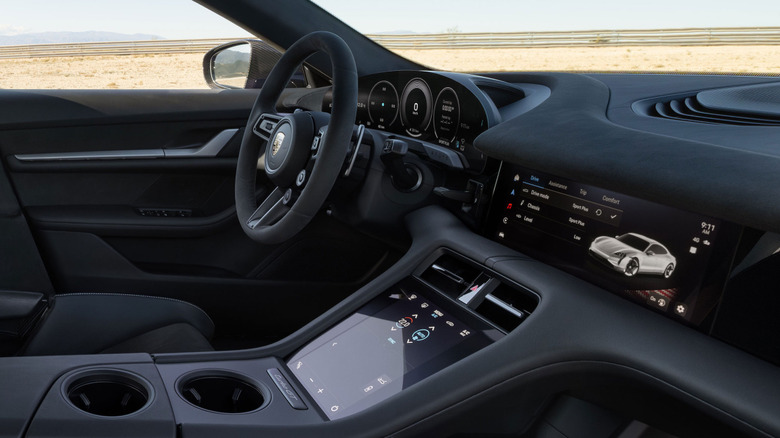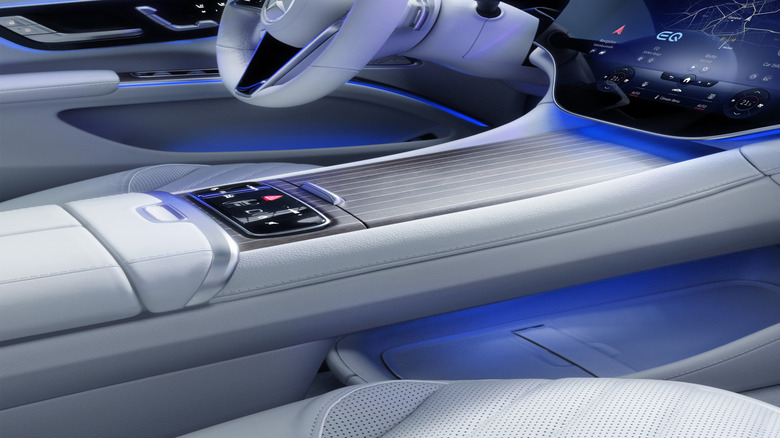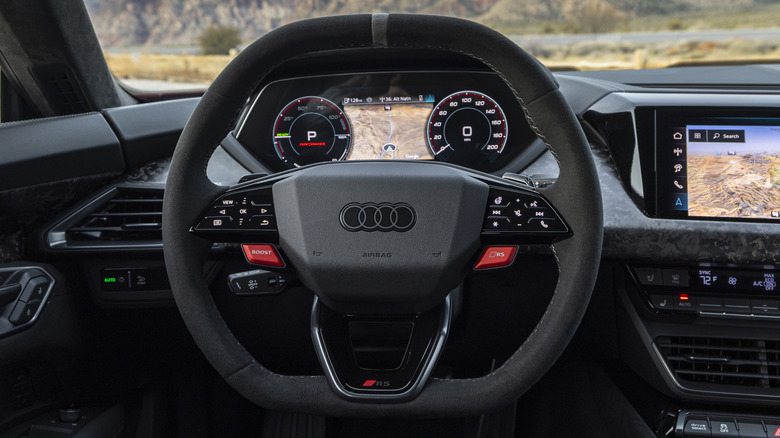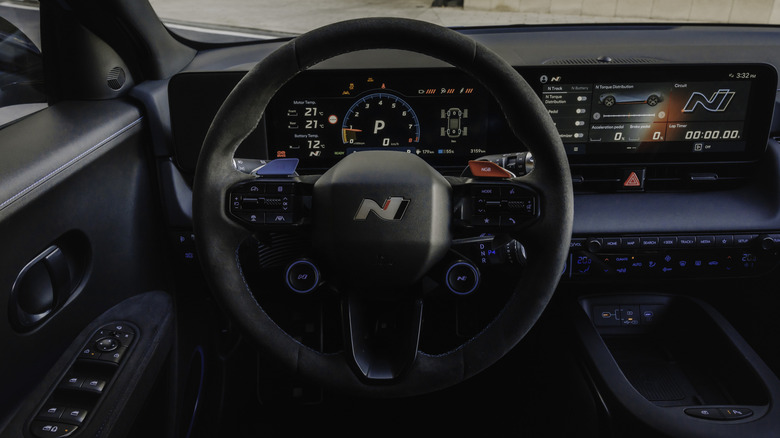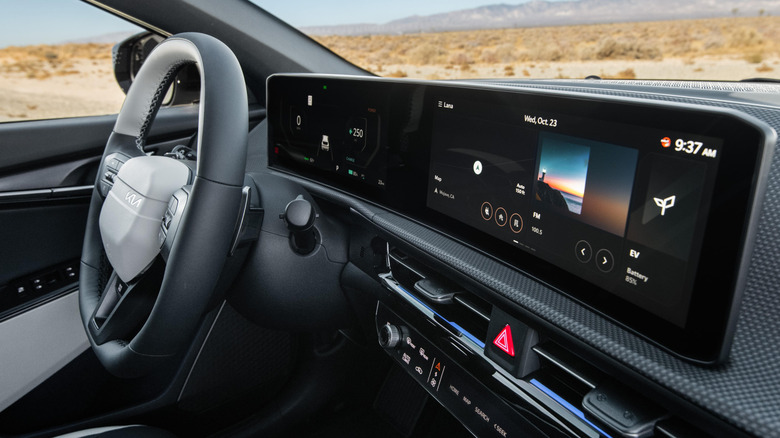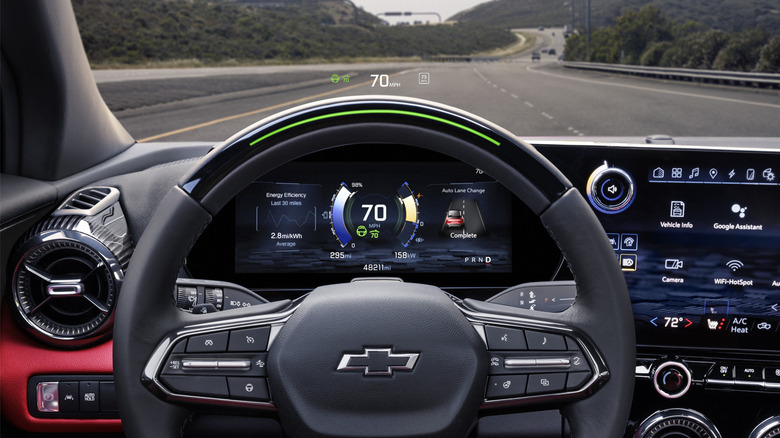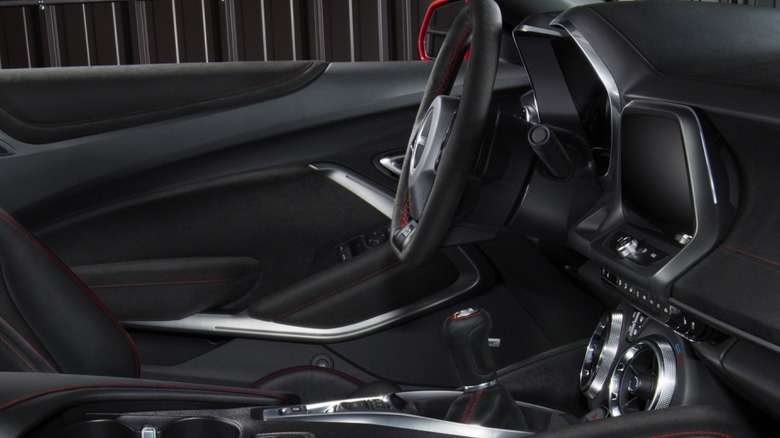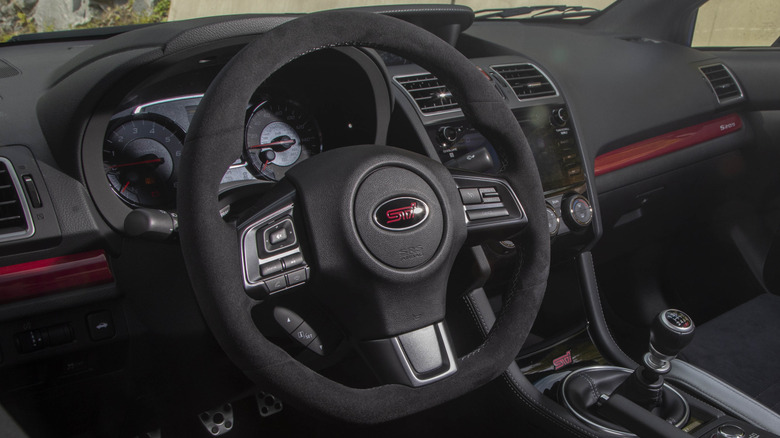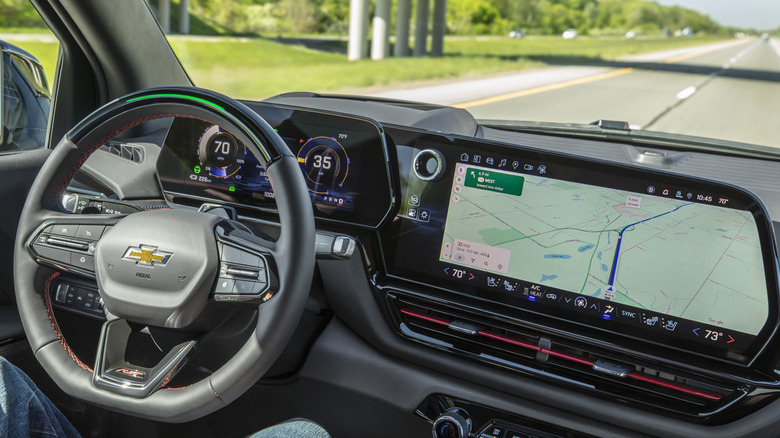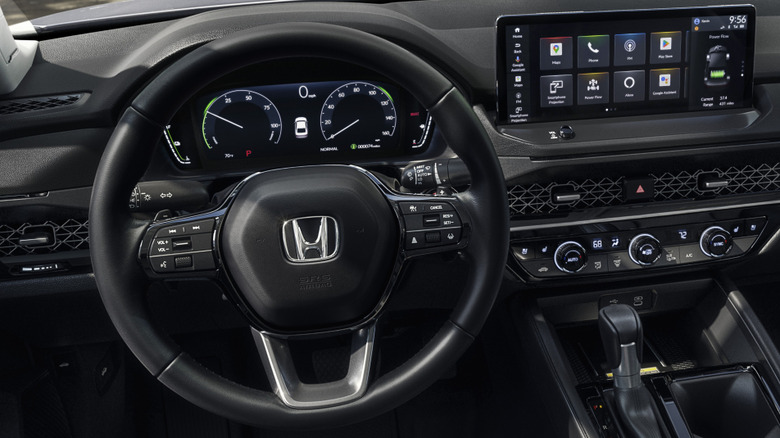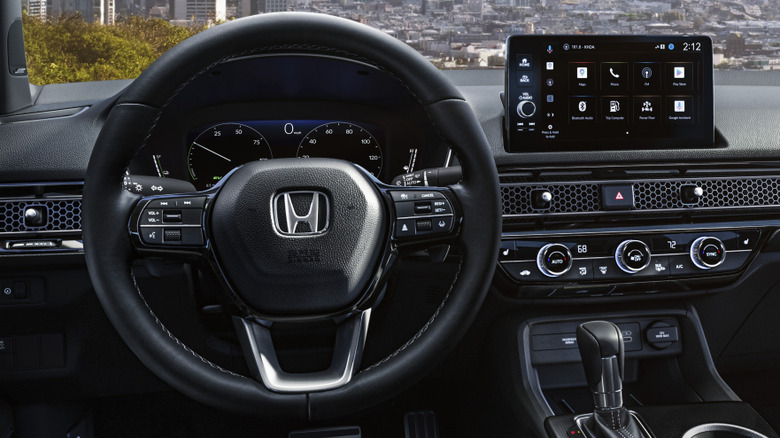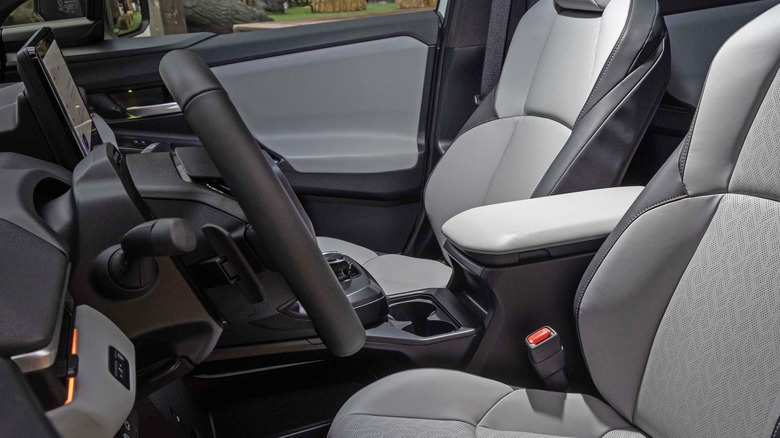12 Cars With Paddle Shifters That Aren't For Changing Gears
We can all probably nod to the fact that manual transmission cars are the most engaging to drive. It's not just the stick shift — you also need to use the clutch pedal at the right time, and let's not get started on heel and toe shifting.
However, modern automatic transmissions can change gears way more quickly than a human being, and allow you to focus more on other parts of driving. But what about engagement? That's what paddle shifters are for. You can keep both your hands on the steering wheel and change gears using your fingers. It's not as involved as a stick shift, but it gives control back to the driver and can make you feel like Max Verstappen.
First introduced to F1 cars in the late 1980s, paddle shifters came to the consumer world in 1995, when Ferrari implemented them in the F355 F1 Berlinetta. Other automakers quickly followed. Today they are common in most automatic performance cars. In fact, many vehicles are also equipped with paddle shifters that aren't for changing gears. But then, what are they for? These 12 models offer some new and innovative uses.
2025 Porsche Taycan Turbo GT
Porsche's PDK dual-clutch transmission changed the game with its lightning-fast gear changes. Using it feels like driving an F1 car, thanks to the paddle shifters behind the steering wheel. But what are those shifters doing on the company's unbelievably quick electric sports car? You won't be changing gears with those. The Taycan has a two-speed transmission on the rear axle, but it doesn't allow for manual gear changes.
Instead, Taycan's left steering paddle is used for energy recuperation. When you activate it, the vehicle will use the electric motors to decelerate, instead of the mechanical brakes. In other words, the motors now act like generators. By doing this, it charges the batteries, maximizing range. Another benefit is that the brake pads are used less frequently, which increases their lifespan. That said, the Taycan doesn't support one-pedal driving, so you'll need to use the brakes to achieve a full stop.
The right paddle is much more of a Porsche thing, as it activates the Attack Mode. In the Taycan Turbo GT, this means you get an additional 163 hp for 10 seconds, or 1,019 hp in total. This feature might come in handy when overtaking on the track, but we guess it's also fun to use occasionally. With Attack mode enabled, the Taycan Turbo GT with the Weissach package reaches 60 in an unbelievable 2.1 seconds!
2025 Mercedes-Benz EQS
The Mercedes-Benz EQS feels flagship-special inside the cabin, with an outstandingly refined driving experience and luxury that exceeds the S-Class. The AMG model we tested is blazingly quick, too. With Boost mode activated, the Mercedes-AMG EQS delivers 751 hp and 752 lb-ft of torque, enough for a brisk 0-60 time of 3.4 seconds. For a high-end luxury sedan, that's more than enough, especially since the EQS wasn't designed with driver's engagement in mind. It's capable, but certainly not on Taycan's level.
Thus, it also makes sense that the AMG EQS doesn't have an Attack mode. Instead, the paddles behind the mega-luxurious steering wheel are used to control the three regenerative braking settings. Unlike its Porsche rival, the EQS allows for one-pedal driving in its most aggressive setting, meaning the vehicle will eventually make a full stop when you ease off the accelerator pedal. One-pedal driving takes some time to get used to. Still, it can significantly improve the range, and some drivers find it very relaxing.
Fortunately, Mercedes-Benz has upgraded the EQS for 2025. In particular, the improved model now has a larger 118-kWh battery (previously 108.4-kWh), which boosts the so-so range of the original we tested. The EQS also received a mild facelift, with a faux grille that's more reminiscent of the brand's gas-powered cars. Unfortunately, the 56-inch wide MBUX Hyperscreen still dominates the dashboard, which can be overwhelming at times.
2025 Audi e-tron GT
The Audi e-tron GT shares the platform with the Porsche Taycan, and has the same, sleek four-door coupe shape. There is also a bonkers RS Performance variant, similar to the Taycan Turbo GT, though with "only" 912 hp. It can still reach 60 in an astonishing 2.4 seconds, which is much quicker than the already bonkers, 637-hp RS e-tron GT we reviewed in 2021. You probably don't need more than that, other than perhaps for bragging rights.
Still, there is one detail available on the Taycan Turbo GT that the RS e-tron GT Performance misses — the Attack mode paddle. Sorry, but you can only use the stunning Vanadium steering paddles to control the regen function, not for an F1-like overtake boost. Instead, Audi opted for a Boost button on the steering wheel. This kills the fun a bit, and makes the feature less useful on the track, because you'll need to remove one hand from the steering wheel. Still, the red Boost button does look cool.
Fortunately, the RS e-tron GT Performance accomplishes every other fun-driving aspect with aplomb. Despite weighing almost 5,200 pounds, the 2022 model we tested felt nimble and playful in the corners. The latest 2025 variant received some upgrades, like active dampers, which should further enhance the handling characteristics. Range has increased as well, thanks to a larger 97-kWh battery, which also supports 320-kW fast charging.
2025 Hyundai Ioniq 5 N
The Hyundai Ioniq 5 N nailed the EV driving excitement part perhaps better than its costlier German rivals. It has all sorts of noises that make it sound like an internal-combustion vehicle, and real paddle shifters. Well, they seem real when you use them. As part of the N e-shift feature, engaging the upshift paddle, for example, will dip torque for a second, making it feel like you changed a gear.
Meanwhile, the N Active Sound + feature will make it sound like the "engine" dipped its rpm, readying for next gear. If you don't engage the right paddle, the "engine" will eventually reach the redline and stop accelerating. Or, if you are in a higher gear, it won't accelerate. Heck, you even hear a throttle blip on downshifts. Damn it, you can even rev out the non-existent engine when in neutral. Not true, sure, but your ears will be fooled!
Such is the story of the Ioniq 5 N — the car with paddles that don't change gears, but feel like they do. Hyundai's N division used electronic trickery to enhance other aspects of the driving experience. There is the N Grin Boost, which gives you the full 641 hp for 10 seconds, and N Drift Optimizer, which, well, lets you drift your family crossover. However, while spacious and practical, the Ioniq 5 N's limited 221-mile range make it not the best family car. The regular Ioniq 5 is probably a better buy, though its paddles are only for regen.
2025 Kia EV6 GT
Kia's counterpart to the Ioniq 5 N also wants some fake gear change foolishness. Hardly surprising, because they are essentially the same cars underneath. Same platform. Same batteries. Identical electric motors. Yup, the high-performance EV6 GT variant also makes 641 hp with Launch Mode enabled, so it's as quick (0-60 in 3.4 seconds). Kia's paddle-shift feature has a more descriptive name — it's literally called "Virtual Gear Shift." Still, it works in the same way, accompanied by fake engine noises. Drift Mode is also available for oversteer enthusiasts. You won't get these features on regular EV6s, though; the paddles in those models are, unsurprisingly, for the regen feature.
The fact that the EV6 GT shares most bits with the Ioniq 5 N also means it has the same downsides. The pre-upgrade EV6 GT was a hard sell because of the comically low 206-mile range. After the 2025 MY update, Kia installs a larger 84-kWh battery, instead of a 77.4-kWh unit, but that's still only enough for a 231-mile range. Still, it's at least higher than the Ioniq 5 N's, probably due to the EV6 GT's more aerodynamically efficient body. On the other hand, the EV6 GT doesn't employ all of its rival's features and performance upgrades, though still has adaptive suspension and limited-slip differential to help you with cornering.
2025 Chevrolet Blazer EV
With its sporty design and advanced Ultium architecture, the Blazer EV is a very attractive electric crossover. It's also very competitive on range, which is what matters in an EV. The single-motor, rear-wheel-drive RS model has an EPA-estimated range of 334 miles, while the high-performance, dual-motor SS variant has a 303-mile range. That's impressive considering it also puts out 615 hp, enough to reach 60 mph in 3.4 seconds.
The Blazer EV also has a neat trick for maximizing range in urban conditions — a paddle positioned behind the left side of the steering wheel, called the "Regen on Demand Paddle." Yes, just like its rivals, the Blazer EV uses a paddle to control regeneration, but it works differently. Instead of choosing between several pre-determined modes, you can directly use the paddle to decelerate. It's similar to using the L2/R2 buttons on a PlayStation gamepad — the harder you pull the paddle, the more it decelerates. This allows for one-pedal driving, only you'll be using your left hand to bring the Blazer EV to a full stop.
Apart from the impressive range, the Chevy Blazer EV is very spacious and comfortable. Hardly surprising, as it's also huge. It's 2 inches longer than the Hyundai Santa Fe, for example. Still, it doesn't offer a third seating row, and its cargo volume isn't very impressive, especially considering its massive footprint. GM also isn't offering Apple CarPlay or Android Auto, though the excellent Super Cruise feature more than makes up for that.
2024 Chevrolet Camaro LT1/SS/ZL1 w/ Manual Gearbox
Wait, is the title pointing out that a Camaro with a manual gearbox has paddle shifters? Yup, you read that right. This implementation is quite interesting, as you use the paddles to activate or deactivate the Active Rev Match functionality. This system will automatically blip the throttle on downshifts to make them smoother, just as you'd would heel and toe shift. It's an incredibly helpful feature that has been used in other cars, like the intelligent manual transmission (iMT) in the Toyota GR Corolla.
Activating it using paddle shifters seems like an overkill, though, as a button would've been fine. Still, GM probably had a lot of paddles in stock, so maybe they thought it would be cooler to use them for this feature. So, the sixth-gen Camaro with the TREMEC TR-6060 six-speed manual was equipped with these paddles. And it was not only the Camaro. Active Rev Match was also available on Cadillac ATS-V with the same six-speed manual, and the C7 Corvette with the TREMEC TR-6070 seven-speed manual.
All these vehicles are discontinued today, so the only way to try these quirky paddles is via the used market. But of course, we'll miss the stick shift even more; currently, the only Chevy sports car you can buy is the mid-engine C8 Corvette, which is only available with a dual-clutch automatic.
2019 Subaru STI S209
Another stick shift car with paddle shifters? You bet! This time, though, the 2019 Subaru STI S209 only has the left paddle, used to activate the intercooler spray. This is an important feature in highly boosted turbocharged engines. Namely, the widely adopted air-to-liquid intercooler uses ambient air to cool the coolant, which is then used to cool the air entering the combustion chamber. Cooler air is denser, meaning more oxygen is available for combustion. In other words, you get more power.
Still, during hot summer days, and particularly on the track, ambient air won't cool the intercooler liquid efficiently. That's where the intercooler sprayer comes in. Water draws temperature to evaporate, so it can quickly reduce the coolant's temperature. So, when you notice your STI S209 dropping power, maybe it's a good idea to use that paddle.
The STI S209 is perhaps the Subaru vehicle that needed this feature the most. Under the bonnet, it packs a 2.5-liter flat-four, with a turbocharger that operates at a 18.9-psu boost. As a result, it produces 341 hp and 330 lb-ft of torque. Even with a six-speed manual, it gets to 60 in brisk 4.4 seconds. It's also the fastest Subaru ever made, with a top speed of 162 mph. Of course, it comes standard with Subaru's rally-derived symmetrical AWD system. Still, the STI folks amped it up with limited-slip differentials on both axles, Driver Controlled Center Differential (DCCD), and Active Torque Vectoring to maximize cornering grip.
2025 Chevrolet Silverado EV
Though the Cybertruck continues to steal headlines, GM is probably producing more useful electric trucks. The Chevrolet Silverado EV has outstanding range and access to Tesla's Supercharger network, making it one of the most appealing electric trucks on sale.
EPA rated at up to 492 miles of range, you won't need to charge the Silverado EV for days. No big surprise, considering the Work Truck trim with Max Range battery has a capacity of 205 kWh. You can maximize the range using the same "Regen on Demand" paddle as in the Blazer EV, which applies stronger deceleration using the electric motors when pulled.
Chevy's electric truck is quick, too; the high-performance RST version has a 754-hp dual-motor powertrain that brings it to 60 in under 4.5 seconds. You can also tow up to 12,500 pounds! That's more than the Cybertruck (11,000 pounds) and F-150 Lightning (10,000 pounds). Chevy even promised a model that would tow 20,000 pounds. For an EV, that's honestly bonkers.
The electric platform allowed GM to also maximize practicality in other areas. The Silverado EV has foldable Multi-Flex Midgate and Multi-Flex Tailgate, which, when utilized, create a massive bed length of 10 feet, 10 inches. That's, again, a big win over its rivals. Unfortunately, GM has stubbornly ditched Apple CarPlay and Android Auto from its range. So, just like the Cybertruck, the Silverado EV also lacks these useful features.
2025 Honda Accord Hybrid
With the latest Accord, Honda is showing that regen paddles also have their place in hybrid vehicles. Honda's implementation is quite straightforward; the left "minus" paddle increases the regenerative effect, while the right "plus" paddle decreases it. The recuperated energy charges the battery, which helps the internal-combustion engine during acceleration, increasing efficiency.
As a result, the Honda Accord Hybrid is a highly fuel-efficient vehicle, rated at 51-mpg city and 44-mpg highway. That's all the more impressive when you consider its performance. The hybrid powertrain combines a 2.0-liter gas engine with two electric motors to produce 204 hp. 0-60 takes only 6.7 seconds, excellent for a fuel-efficient mid-size sedan. The hybrid comes with a CVT as standard. However, it's programmed to behave like a regular automatic and does that very well.
Still, the Accord Hybrid has a lot more to offer. Its cabin is nicely appointed, with a button-rich dashboard that's easy to use while driving. Moreover, all passengers will be comfortable, even those in the rear. Equipment levels are generous across all trims, too. Unfortunately, unlike the latest Toyota Camry, there is no AWD option on the Accord Hybrid. In addition, Toyota's hybrid mid-size sedan is more economical, while providing about the same acceleration as the Accord.
2025 Honda Civic Hybrid
Using the a similar 200-hp, 2.0-liter hybrid powertrain as the Accord Hybrid, but in a much smaller and lighter body, the Civic Hybrid can reach 60 mph in only 6.2 seconds. That's mightily impressive for a car rated at 47-mpg highway and 50-mpg city. Heck, the Civic Hybrid is quicker than the sporty Si model to 60 by almost half a second. With more power and mpg, the Civic Hybrid also costs more money, but it more than makes up for that with its excellent performance and efficiency.
Just like the Accord, the Civic Hybrid has steering wheel paddles to control the strength of the regenerative braking feature. There is still no one-pedal driving, though, which seems like a missed opportunity. Also, Honda could've probably made them double purpose. Since the CVT already has pre-programmed stepped gears, and the Civic has excellent driving dynamics, real paddle shifters would've significantly improved the driving engagement.
As it stands, the Civic Hybrid is pleasant to drive on twisty roads, but far from sensational. So, although quicker, it's less fun to drive than the stick-shift-operated Civic Si. Still, as a fuel-efficient compact car, the Civic Hybrid is hard to beat. It's quiet and smooth and offers plenty of space inside the cabin.
2026 Subaru Solterra
Subaru has significantly improved the Solterra for 2026. It has a sleeker design, with the previous model's black cladding now painted the same color as the rest of the body. The front end is sharper and more modern, too. Crucially, the Japanese brand's sole EV now has up to 25% longer range, thanks to a new 74.7-kWh battery, an upgrade over the 72.8-kWh unit of the 2025 model.
As a result, the 2026 Solterra can go up to 285 miles on a charge, despite packing a potent, 233-hp dual-motor powertrain as standard. Eco-conscious WRX STI enthusiasts now have the option of a more powerful Solterra XT trim, which packs 338 hp and sprints to 60 in just 5 seconds. The battery can also charge faster, thanks to improved pre-conditioning, and drivers can now also use Tesla's Supercharger network.
Looking at the images, it's evident that Subaru retained the paddles behind the steering wheel. However, they aren't there to satisfy your WRX rally dreams. Introduced for the 2024 MY, these paddles let you control the strength of the energy recuperation feature. The Solterra is also equipped with the S-Pedal feature, which lets you drive mostly with the accelerator pedal. Still, it won't bring the vehicle to a full stop, and Subaru didn't mention changing this for the 2026 model in its press release.
